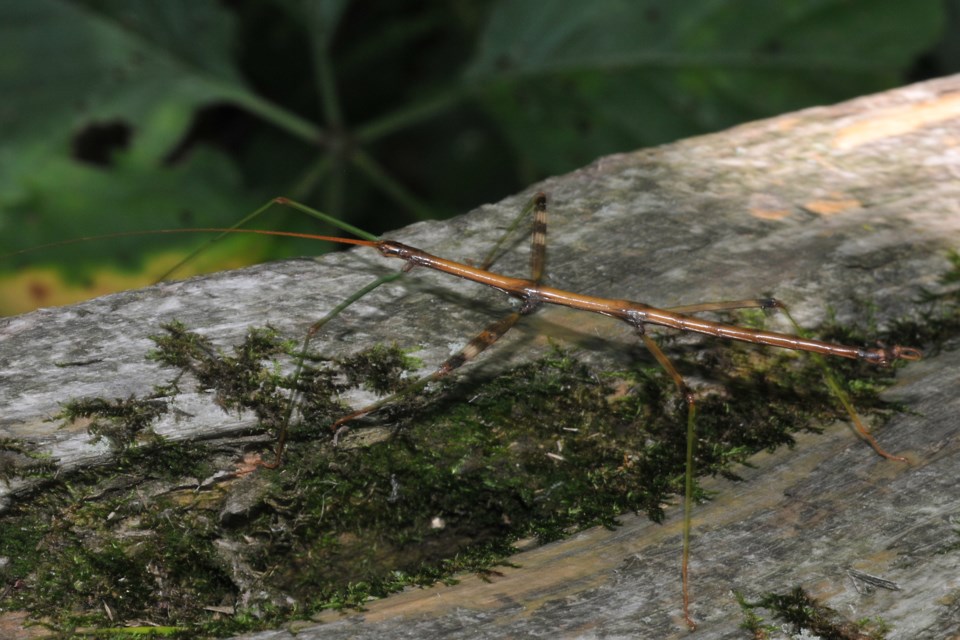Any hiker who has covered more than a couple of kilometres will attest to the usefulness of a walking stick. However, 'walking sticks' can be more than just an ornately carved tree branch — they can also be very interesting insects.
The living type of walking stick is usually found in wooded areas, reaching a length of about four inches when mature (for the benefit of younger readers who haven't a clue as to Imperial measure, four inches can be converted to about the width of an adult's hand). In late summer they are more easily seen than earlier in the year, simply because they are now big enough to notice.
Looking exactly as their name implies, these insects are superbly camouflaged and to find one takes a bit of patience, a keen eye and a bunch of luck.
Try looking on the leaves of young elm, ash or maple trees. Common names for these insects are walking stick, stick bug (not correct as these are not true bugs), stick insect, or Devil’s darning needle (oh dear, maybe we need some sensitivity training on this name).
There are some summers when every tree is home to at least one of these stilt-legged creatures, while other years they were harder to find than a job in a recession. The reason for this, as I have just recently discovered, is that the eggs take 20 months to develop. This results in every other year being a bumper crop of walking sticks.
Not only do these gently moving creatures look bizarre, their life cycle is just as curious. The females are capable of laying eggs without the benefit of a mate, a process known as parthenogenesis (partheno = without fertilization; genesis = birth). If a suitable male is not located, then she simply produces her own viable eggs. Which begs the question: why have males?
So how does a female walking stick ensure her eggs will survive undefended for almost two years? Are they encased in a watertight membrane? Are they buried out of sight? Nah… she just lets 'em fly willy-nilly from the tree tops in hopes they will be protected from weather and predators by the layer of dead leaves on the forest floor.
Some of these eggs will be collected by ants, taken back to the colony and the outer fatty coating removed as food; the seemingly inedible core will then be dropped in the waste bin and continue to develop in a secure place.
The eggs lay there for a winter, a summer, another winter, and a bit of the following spring. Once hatched, the little gals will molt their skin six times as they grow that year, becoming adults by late summer.
These insects can also change colour, as we witnessed in our yard a few years ago. A bright orange play tent was set up in the yard and a walking stick was found making its way up the side. Perhaps it was trying to match the colour of its surroundings, but try as it did, bright green was as good as it got, still standing out like a scratch on a new car.
When scooped off the tent and offered a twig, it took to the natural stuff most readily, and 'ping', turned a dark brown! Just the body though, the legs stayed the brilliant green. When then placed on a branch of green leaves it stayed brown, probably exhausted from the previous rapid transformation.
There is another interesting trait these insects can do ... play dead — something researchers call thanotosis. These (mainly) female insects can determine if they are threatened by danger, and will drop to the forest floor and just lay there, looking very much like all the other dead branches.
Okay, in case there is a pop quiz on this, let's review: stick insects are not bugs, they can fertilize their own eggs, change colour at will and conduct thanotosis. Anything else? Just one more tid-bit — they can do something called autotomy. This, in simpler terms, means that they are capable of self-amputation.
Should a leg become injured or caught in the beak of a bird, it can be sacrificed. At a certain joint in the legs, there is a two-layered membrane that does not allow muscles to cross, and separation can occur easily if necessary. A new leg may grow back during the next molt, but at least life goes on.
As you hike about the woodlands over the next few weeks keep an eye open for the fascinating walking stick. They are quite harmless, and may even appreciate a ride upon your own finely carved walking stick.


